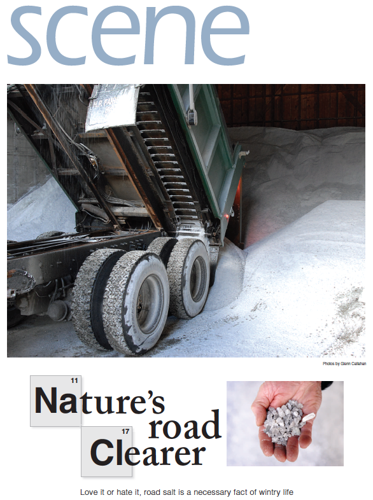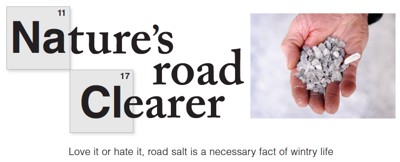Some 2,500 years ago, the Romans built roads to transport a substance of extraordinary value: salt.
Today, salt and roads are still connected — the mineral plays a key role in keeping modern roadways clear of ice.
The substance that cooks use to add flavor to meals is largely the same as the pebble-sized salt rocks that road crews in wintry climes use to de-ice highways.
But where chefs add a pinch here and there to the soup, road salt is applied with the gusto of someone curing a piece of meat.
Many Vermont drivers take salt for granted, and many more curse the briny white film it leaves underneath and all around their cars.
But that simple, everyday mineral is borderline magical in its ability to melt ice rapidly.
“The stuff works quick,” said Jason Wells, who drives a snowplow for the Stowe Highway Department. “I tell cars, if they get stuck on the side of the road, just wait five minutes after I go by, and they’ll be good to go.”
How it works
Remember this little experiment from when you were a kid? Place a string on top of an ice cube and sprinkle a tiny bit of table salt on top. Let it sit a few minutes, and voila! You can just pull the string and the ice cube stays attached to it.
Salt, or sodium chloride (NaCl), is a compound made of two elements, sodium and chlorine. It works this way on ice: It lowers the freezing point of water. As soon as the ice begins dissolving, more water is formed, allowing more salt to dissolve, and furthering the melting process.
Salt doesn’t work on icy roads when temperatures get too far below freezing. Road crews don’t even bother putting it down when the temperature gets under 20 degrees Fahrenheit, opting for sand instead. While sand provides traction, it has no melting powers.
“It’s never much fun when everything’s a sheet of ice,” Wells said.
Road crews never put salt down on dirt roads, either, said Steve Bonneau, Stowe’s highway superintendent. The same science that lowers the freezing point of ice also thaws out frozen dirt roads, and it continues to work as it gets warm, until it gets fully dissolved.
If dirt roads were salted, “you’d have a real mud problem next spring,” Bonneau said. “Not that we don’t have a bad enough problem every spring as it is.”
Liquid salt
Tom Anderson, project manager with the Vermont Transportation Agency, handles much of the salt-buying for the state government. He said he’s never actually pondered just how salt’s chemistry works, but he knows the results: The minute salt begins mixing with water, it starts to act.
In an effort to make ice-clearing more efficient, the state began using a liquefied salt brine on roads a few years ago, instead of just the old reliable, salt. The brine is mostly laid down on the interstate highways. State trucks routinely lay down briny batches when the roads are dry, and the brine gets at ice before it can even form.
“The minute salt starts mixing with water, it starts to react,” Anderson said. “The trucks also have the ability to spray the salt as it comes out of the truck, and turn it into an oatmeal consistency.”
Salt brine does have naysayers; some claim the liquid salt eats away at cars faster than the original. Some say brine leads to more black ice because it works too well, uniformly melting the ice — but then the water refreezes as soon as temperatures drop below 15 to 20 degrees.
“Salt brine’s a bad solution,” said Rick Carrick of Stowe, while sitting in the waiting room at Willie’s Auto, where plenty of people have plenty of opinions on road salt, none of them too positive. “All that black ice in Bolton (on I-89) is from that.”
Bonneau said Stowe is taking a wait-and-see stance on brine, because it would cost $20,000 to $30,000 to equip town highway gear to use it.
“I’ll just kinda lean back and let them do it for a couple years,” Bonneau said.
Rusty hulks
For its benefits in melting ice, sodium chloride wreaks havoc on things made of metal, especially Vermont vehicles.
In Vermont, car bodies will often rust out before their engines give out, says Willie Noyes, owner of Willie’s Auto; he’s also a Stowe Select Board member. Noyes said some of the worst cars he services are owned by Stowe second-home owners who may come up for a few weeks of skiing in the winter, drive around all that time on salty roads, and head back to warmer climes, leaving their cars parked unused for the rest of the cold season.
Noyes said the salt and snow mixture sticks to the undersides of vehicles, gets caked up all winter, and starts to eat away at the metal. Exhaust systems become perforated with holes, and brakes that would otherwise be good for thousands more miles rust away before the pads wear down.
Three years after being driven new off the lot, a Vermont car is already rusting out, he says.
“Every single metal part on the car rusts out,” Noyes said. “Every bolt you try to remove, you’ve got to use a blowtorch to loosen it up.”
Noyes thinks the state’s brine program has made the problem worse, and road salt was already bad enough. He said the brine is stickier than rock salt; it adheres to cars, and then everything sticks to it.
Anderson, the VTrans buyer, said there’s no real difference between brine and road salt.
“A lot of people think the salt brine is a special mixture that’s ruining their cars, but all salt brine is is salt and water,” Anderson said.
Where it comes from
Stowe and the Vermont Agency of Transportation buy road salt in bulk from one of two large companies, American Rock Salt or Cargill. Both corporations own huge mines in upstate New York; Cargill has one a half-mile beneath Cayuga Lake and American Rock Salt owns one near Lake Ontario. American Rock Salt boasts the largest salt mine in the country, producing 10,000 to 18,000 tons a day for Northeast and New England states.
Anderson handles road-salt ordering for the state, and said the state goes through about 120,000 tons of sodium chloride per winter. He said the product VTrans gets is pretty consistent — a mix of pebbly crystals and pulverized salt that does double duty for immediate melting and long-term de-icing.
Bonneau said Stowe gets regular deliveries from the salt providers, enough to fill the town’s salt shed at least a couple of times per winter. The shed is next to the town garage on River Road and, judging by the deer prints in the ice, a popular snack bar for sodium-loving ruminants.
The shed cannot hold all the salt Stowe goes through in a typical winter, about 2,000 tons a year, so the town keeps getting refills. In really snowy years, the salt shed has gone completely empty, and the Stowe road crews ended up just filling up the fleet right off the providers’ delivery trucks.
“It gets close, but they’ve never let us run out,” Bonneau said.









(1) comment
I have no problems with the salt industry. I use it, liberally, on my food. I live in Montana, now, and we don't use salt on our roads. Instead, we teach our drivers how to drive in snow conditions and (Attention, Ladies) what the "button", or stick "thingie" is that engages the 4-wheel-drive in vehicles! The use of salt is a moneymaker in Vermont. For the state (more vehicle inspection fees) and the auto repair industry (more rust-out replacements/repairs).
Shakey Hays @ negative (-) 10 F., and snowing. Love it!
Welcome to the discussion.
Log In
Keep it clean. Please avoid obscene, vulgar, lewd, racist or sexual language.
PLEASE TURN OFF YOUR CAPS LOCK.
Don't threaten. Threats of harming another person will not be tolerated.
Be truthful. Don't knowingly lie about anyone or anything.
Be nice. No racism, sexism or any sort of -ism that is degrading to another person.
Be proactive. Use the "Report" link on each comment to let us know of abusive posts.
Share with us. We'd love to hear eyewitness accounts, the history behind an article.